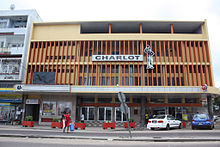Draft:Marcos Miranda Guedes
 | Draft article not currently submitted for review.
This is a draft Articles for creation (AfC) submission. It is not currently pending review. While there are no deadlines, abandoned drafts may be deleted after six months. To edit the draft click on the "Edit" tab at the top of the window. To be accepted, a draft should:
It is strongly discouraged to write about yourself, your business or employer. If you do so, you must declare it. Where to get help
How to improve a draft
You can also browse Wikipedia:Featured articles and Wikipedia:Good articles to find examples of Wikipedia's best writing on topics similar to your proposed article. Improving your odds of a speedy review To improve your odds of a faster review, tag your draft with relevant WikiProject tags using the button below. This will let reviewers know a new draft has been submitted in their area of interest. For instance, if you wrote about a female astronomer, you would want to add the Biography, Astronomy, and Women scientists tags. Editor resources
Last edited by WereSpielChequers (talk | contribs) 48 days ago. (Update) |




Marcos João Garcia Miranda Guedes, briefly Marcos Miranda Guedes (* 6. June 1924 in Peso da Régua, Portugal; † 2001 in Portugal) was a portuguese architect.
Life[edit]
Miranda Guedes was born on June 6, 1924 in Peso da Régua, northern Portugal. After his school education, he studied architecture at the Escola Superior de Belas Artes (Higher School of Arts) in Porto, He completed his studies in 1952. While studying architecture, Miranda Guedes worked in the architectural studio of José Carlos Loureiro. He later moved to the architectural studio of José Gomes Bastos, where he was involved in the final planning of the Banco Nacional Ultramarino new buiding (today the headquarters of the Mozambican Central Bank), Lourenço Marques (today Maputo) references.[1]
Due to a lack of orders, Miranda Guedes - like many young Portuguese architects of the time - moved to the Portuguese colony of Mozambique, where he hoped to find more work. Initially, Gomes Bastos commissioned him to supervise the construction of the new bank building, which he had previously helped plan. However, this ultimately did not happen because the bank decided not to supervise the construction.
During his sixteen years in Mozambique, Miranda Guedes designed numerous striking buildings for the colony's capital, numerous - for both government and private clients - together with Octávio Pó. In particular, the Historical Archive building, completed in 1960, and the "Prédio 33" (1967–82/83), known as "building 33" because it has 33 floors and was then as now the tallest building in Lourenço Marques (today Maputo), still characterize the city today and were seen at the time as a sign of Mozambique's modernization.
In addition to his assignments, Miranda Guedes also taught at the professional school Escola Industrial Mouzinho de Albuquerque. With the independence of Mozambique in 1975, Miranda Guedes returned to Portugal. He died there in 2001.
Works[edit]
- 1954–64: Banco Nacional Ultramarino new building, Lourenço Marques [Maputo]; in collaboration with José Gomes Bastos[1][2]
- 1958: Kakhoobai building, Lourenço Marques [Maputo]
- 1958: António Figueiredo building, Lourenço Marques [Maputo][3]
- 1958: António Rocha Martins building, also known as "Prédio Ronil“, Lourenço Marques [Maputo][3]
- 1959: Carlos Miranda house, Lourenço Marques [Maputo][3]
- 1959: José Galhardo e Guilherme Moutinho house, Lourenço Marques [Maputo][3]
- 1959: Pereira building, Lourenço Marques [Maputo][3]
- 1959: Refrigerator/Cold room of Cervejas Reunidas de Moçambique (Beer Factory), Lourenço Marques [Maputo][3]
- 1960–63: Banco Nacional Ultramarino residential building for civil servants in António Enes [Angoche], Porto Amélia [Pemba] und Tete[3]
- Approximately 1960: xpansion of the Conselho de Câmbios, Estatística e Arquivo Histórico building, Lourenço Marques [Maputo][4]
- 1960–63: DETA offices, Lourenço Marques [Maputo], in collaboration with Octávio Pó[5]
- ̣1961: Kinderklinik, Lourenço Marques [Maputo][3]
- 1962: Sociedade de Estudos, Lourenço Marques [Maputo][3]
- 1963: Cinema Charlot, Lourenço Marques [Maputo][6]
- 1964–68: Seminário Pio X., Lourenço Marques [Maputo][3]
- 1967–82/83: Prédio 33, Lourenço Marques [Maputo], in in collaboration with Octávio Pó and Alberto Soeiro[7]
- 1968: Escola Técnica dos Serviços de Saúde e Assistência, Lourenço Marques [Maputo][3]
Bibliography[edit]
- ^ a b "Banco Nacional Ultramarino (atual Banco de Moçambique)". Património de Influência Portuguesa (HPIP) (in Portuguese). Fundação Calouste Gulbenkian. 2012-10-18. Retrieved 2016-01-29.
- ^ Tiago Lourenço (2011). "Edifício do Banco Nacional Ultramarino (BNU) / Edifício do Banco de Moçambique". Sistema de Informação para o Património Arquitectónico (in Portuguese). Retrieved 2016-01-29.
- ^ a b c d e f g h i j k Ana Tostões, ed. (2014). Arquitetura Moderna em África: Angola e Moçambique (1st ed.). Lissabon: Caleidoscópio. p. 444. ISBN 978-989-658-240-1.
- ^ Tiago Lourenço (2011). "Edifício do Conselho de Câmbios e Estatística / Arquivo Histórico". Sistema de Informação para o Património Arquitectónico (in Portuguese). Retrieved 2016-01-29.
- ^ António Sopa (2012-09-25). "Aeroporto Internacional de Mavalane (depois Aeroporto Gago Coutinho, hoje Aeroporto Internacional de Maputo)". Património de Influência Portuguesa (HPIP) (in Portuguese). Fundação Calouste Gulbenkian. Retrieved 2016-01-29.
- ^ Tiago Lourenço (2011). "Cine Charlot". Sistema de Informação para o Património Arquitectónico (in Portuguese). Retrieved 2016-01-29.
- ^ Tiago Lourenço (2011). "Prédio "33 andares"". Sistema de Informação para o Património Arquitectónico (in Portuguese). Retrieved 2016-01-29.
